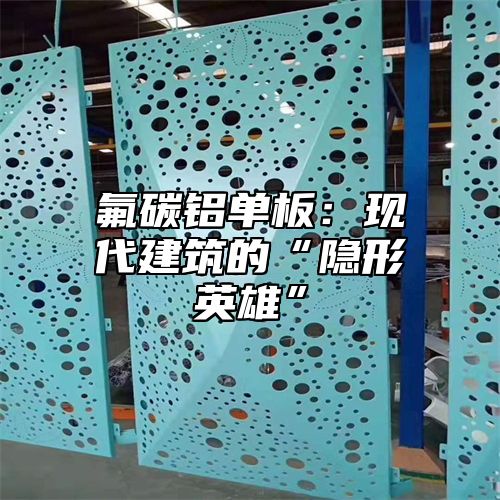

 Industry information
Industry information
You know what? In modern architecture, there is a low-key yet indispensable material, which is fluorocarbon aluminum veneer. It is like an 'invisible hero' in the architecture industry, silently guarding every inch of the building's skin.
First of all, what is this fluorocarbon aluminum veneer? It is to use aluminum plates that have undergone special processing and coated with a layer of fluorocarbon paint on the surface. It may sound a bit high-end, but in fact, it is right around us, such as those skyscrapers and commercial complexes, whose curtain walls are likely to use this thing.
Why is it called an 'invisible hero'? You have to know that the thing architecture fears the most is the 'aging dragon clock'. Over time, wind and rain can easily cause the wall to peel off and fade, affecting its appearance. But fluorocarbon aluminum veneer is different. Its layer of fluorocarbon paint has excellent weather resistance, not afraid of wind and rain, and can maintain a long-lasting freshness. This is like putting on an 'immortal robe' to keep the building youthful forever.
This fluorocarbon aluminum veneer also has a magical ability - self-cleaning. Under sunlight, it can generate weak static electricity on its surface, attracting dust and dirt to the surface and cleaning it with just a wipe. This is equivalent to equipping it with a "cleaning expert" to keep the building clean at all times.
Of course, it's not omnipotent either. You will see that after using fluorocarbon aluminum veneer in some buildings, scratches and fading appear on the surface after a few years. This is actually caused by improper construction and inadequate maintenance. Material selection is important, as are construction and maintenance.
I remember once I went to visit a newly built office building. The curtain wall of that building is made of fluorocarbon aluminum veneer, with a shiny surface like new. I curiously asked the architect, "Is this fluorocarbon aluminum veneer really that durable?" The architect replied with a smile, "The key still depends on construction and post maintenance
This reminds me of a building in my residential area that also uses fluorocarbon aluminum veneer. At the beginning, the building was bright and shiny, but within a few years, it began to fade and scratch. Owners have complained one after another, saying that the developer's materials are not reliable. Later, the community organized a comprehensive inspection and found that it was due to inadequate daily maintenance. After rectification, the building has regained its former glory.
So, although fluorocarbon aluminum veneer is a good material, in order to maximize its effectiveness, it still needs to rely on construction and post maintenance. It's like a person, just having good genes, without hard work, it's difficult to become successful.
With the continuous development of technology, fluorocarbon aluminum veneer is also constantly being upgraded. A new type of fluorocarbon aluminum veneer has emerged on the market, which adopts nanotechnology and not only has stronger weather resistance, but also effectively resists harsh environments such as acid rain and salt spray. This is like putting a "golden bell cover" on fluorocarbon aluminum veneer, making it even stronger.
Fluorocarbon aluminum veneer plays an important role in modern architecture. It is not only beautiful and elegant, but also durable and easy to maintain, becoming the "invisible hero" of modern architecture. To maximize its effectiveness, it still relies on the joint efforts of each and every one of us. After all, architecture is the soul of a city, and fluorocarbon aluminum panels are the guardians of this soul.